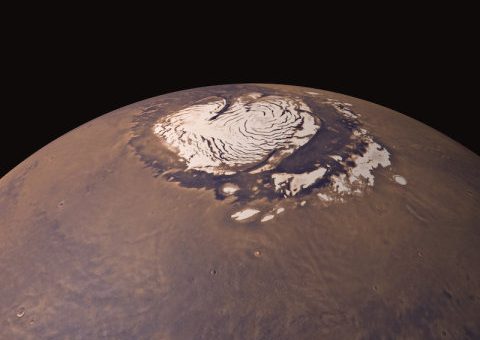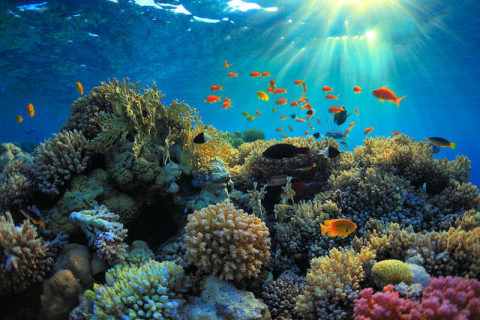
People have long dreamed of re-shaping the Martian climate to make it livable for humans. Carl Sagan was the first outside of the realm of science fiction to propose terraforming. In a 1971 paper, Sagan suggested that vaporizing the northern polar ice caps would “yield ~10 s g cm-2 of atmosphere over the planet, higher global temperatures through the greenhouse effect, and a greatly increased likelihood of liquid water.”
Sagan’s work inspired other researchers and futurists to take seriously the idea of terraforming. The key question was: are there enough greenhouse gases and water on Mars to increase its atmospheric pressure to Earth-like levels?
In 2018, a pair of NASA-funded researchers from the University of Colorado, Boulder and Northern Arizona University found that processing all the sources available on Mars would only increase atmospheric pressure to about 7 percent that of Earth – far short of what is needed to make the planet habitable.
Terraforming Mars, it seemed, was an unfulfillable dream.
Now, researchers from the Harvard University, NASA’s Jet Propulsion Lab, and the University of Edinburgh, have a new idea. Rather than trying to change the whole planet, what if you took a more regional approach?
The researchers suggest that regions of the Martian surface could be made habitable with a material — silica aerogel — that mimics Earth’s atmospheric greenhouse effect. Through modeling and experiments, the researchers show that a two to three-centimeter-thick shield of silica aerogel could transmit enough visible light for photosynthesis, block hazardous ultraviolet radiation, and raise temperatures underneath permanently above the melting point of water, all without the need for any internal heat source.
The paper is published in Nature Astronomy.
“This regional approach to making Mars habitable is much more achievable than global atmospheric modification,” said Robin Wordsworth, Assistant Professor of Environmental Science and Engineering at the Harvard John A. Paulson School of Engineering and Applied Sciences (SEAS) and the Department of Earth and Planetary Science. “Unlike the previous ideas to make Mars habitable, this is something that can be developed and tested systematically with materials and technology we already have.”
“Mars is the most habitable planet in our Solar System besides Earth,” said Laura Kerber, Research Scientist at NASA’s Jet Propulsion Laboratory. “But it remains a hostile world for many kinds of life. A system for creating small islands of habitability would allow us to transform Mars in a controlled and scalable way.”
The researchers were inspired by a phenomenon that already occurs on Mars.
Unlike Earth’s polar ice caps, which are made of frozen water, polar ice caps on Mars are a combination of water ice and frozen CO2. Like its gaseous form, frozen CO2 allows sunlight to penetrate while trapping heat. In the summer, this solid-state greenhouse effect creates pockets of warming under the ice.
“We started thinking about this solid-state greenhouse effect and how it could be invoked for creating habitable environments on Mars in the future,” said Wordsworth. “We started thinking about what kind of materials could minimize thermal conductivity but still transmit as much light as possible.”
The researchers landed on silica aerogel, one of the most insulating materials ever created.
Silica aerogels are 97 percent porous, meaning light moves through the material but the interconnecting nanolayers of silicon dioxide infrared radiation and greatly slow the conduction of heat. These aerogels are used in several engineering applications today, including NASA’s Mars Exploration Rovers.
“Silica aerogel is a promising material because its effect is passive,” said Kerber. “It wouldn’t require large amounts of energy or maintenance of moving parts to keep an area warm over long periods of time.”
Using modeling and experiments that mimicked the Martian surface, the researchers demonstrated that a thin layer of this material increased average temperatures of mid-latitudes on Mars to Earth-like temperatures.
“Spread across a large enough area, you wouldn’t need any other technology or physics, you would just need a layer of this stuff on the surface and underneath you would have permanent liquid water,” said Wordsworth.
This material could be used to build habitation domes or even self-contained biospheres on Mars on Mars.
“There’s a whole host of fascinating engineering questions that emerge from this,” said Wordsworth.
Next, the team aims to test the material in Mars-like climates on Earth, such as the dry valleys of Antarctica or Chile.
Wordsworth points out that any discussion about making Mars habitable for humans and Earth life also raises important philosophical and ethical questions about planetary protection.
“If you’re going to enable life on the Martian surface, are you sure that there’s not life there already? If there is, how do we navigate that,” asked Wordsworth. “The moment we decide to commit to having humans on Mars, these questions are inevitable.”
Credit: Source link












